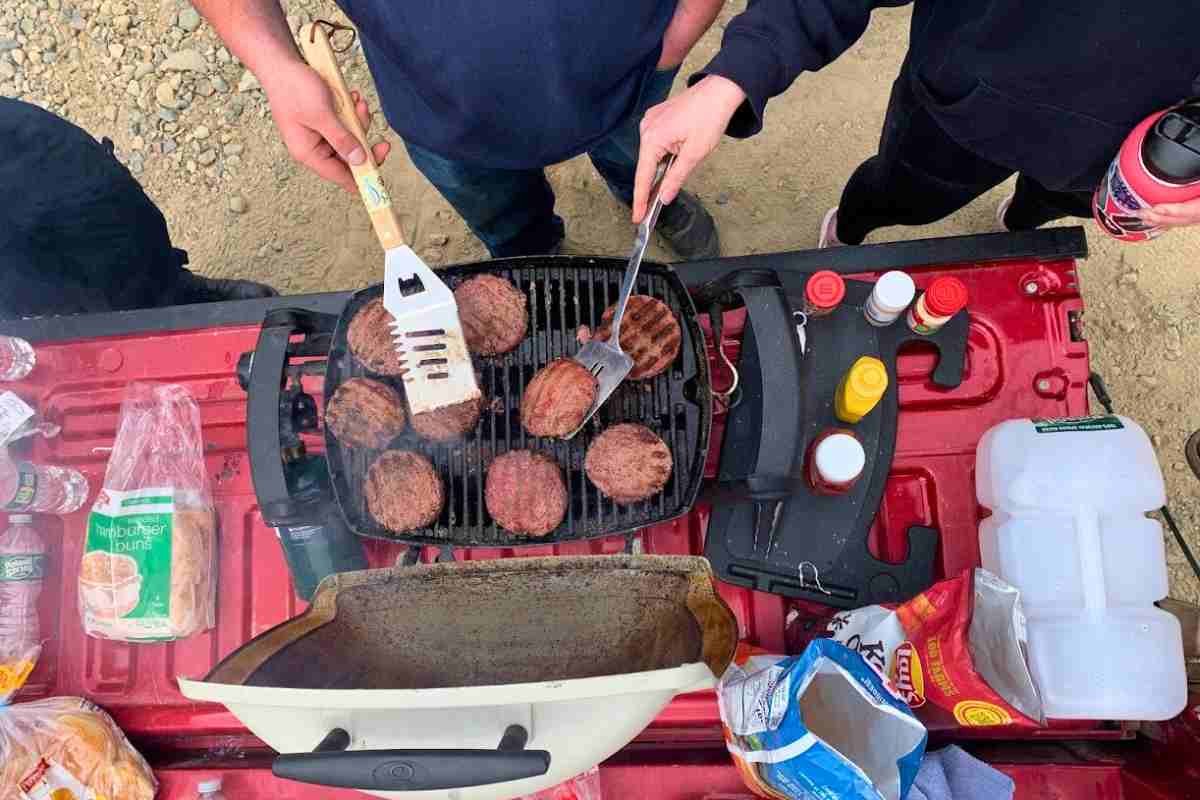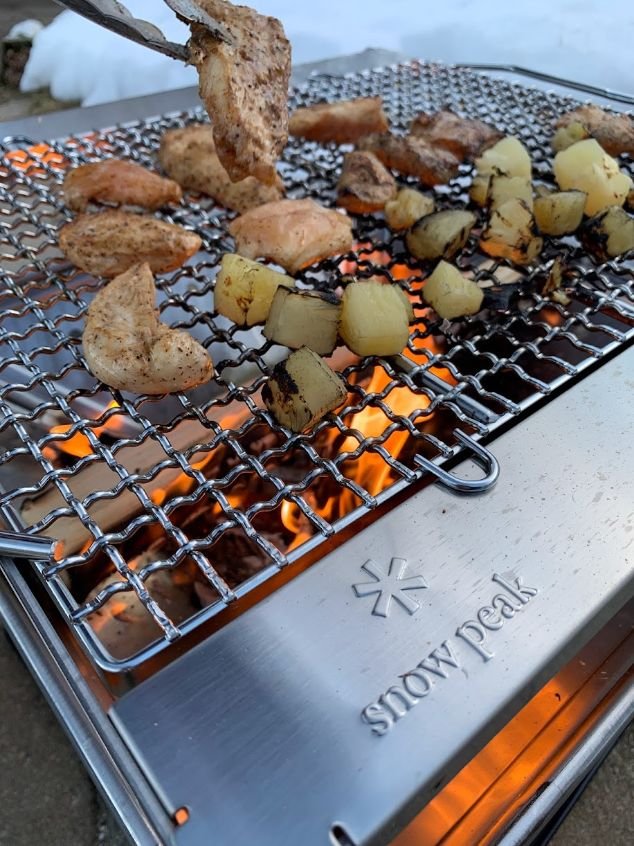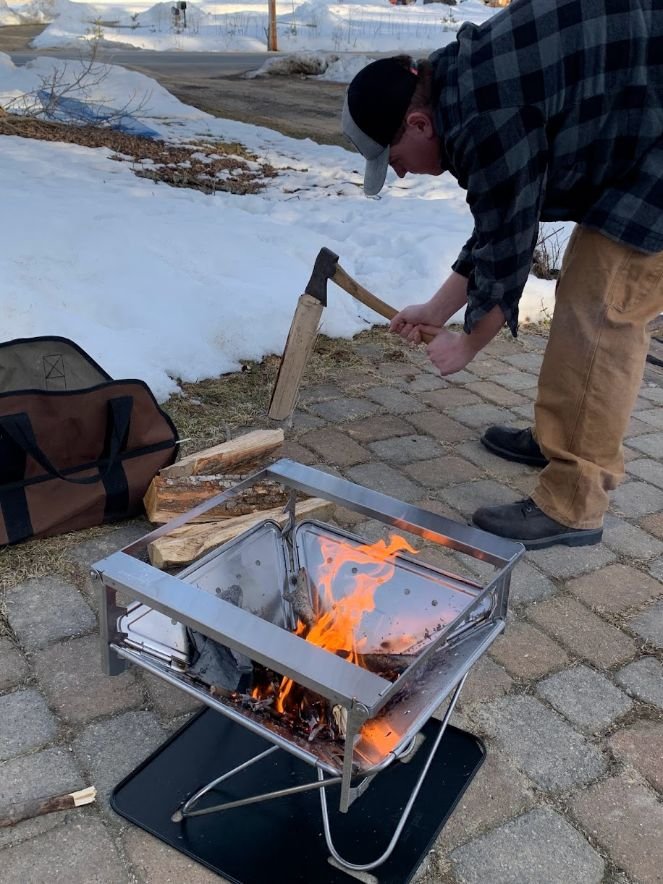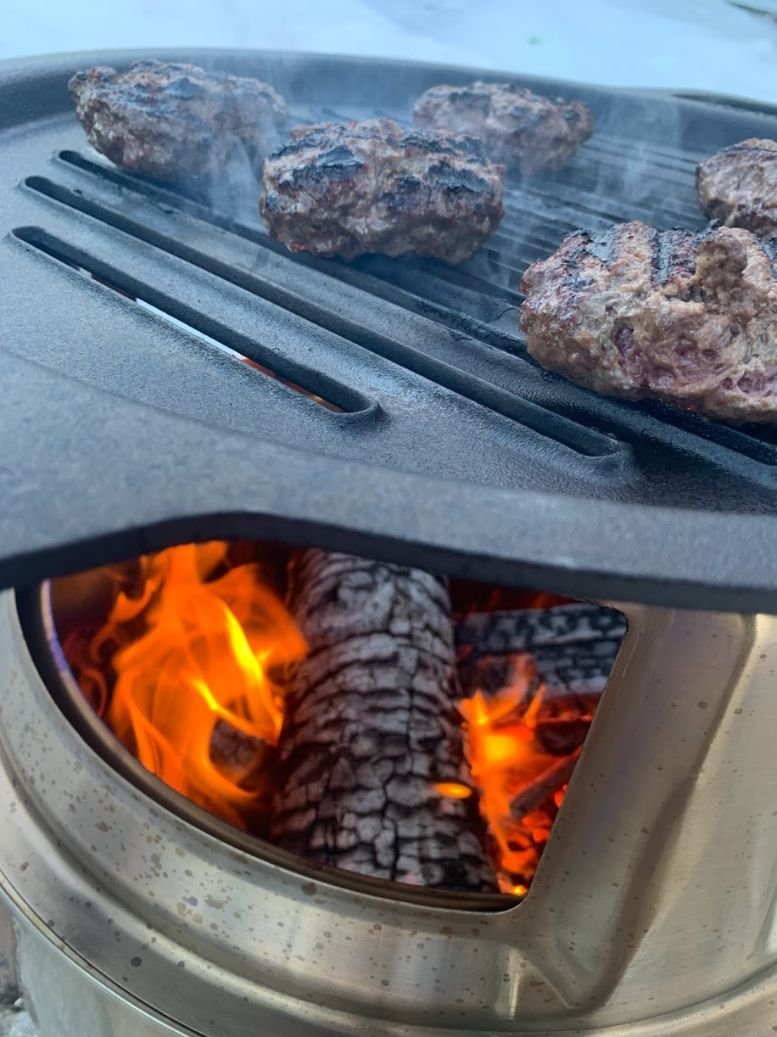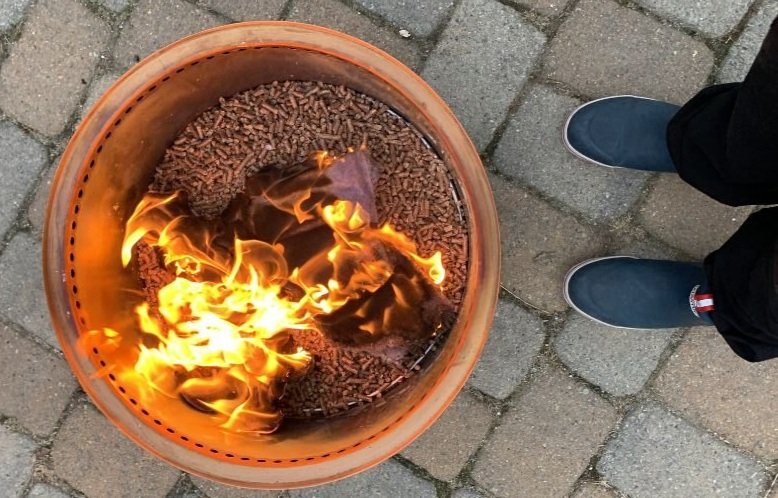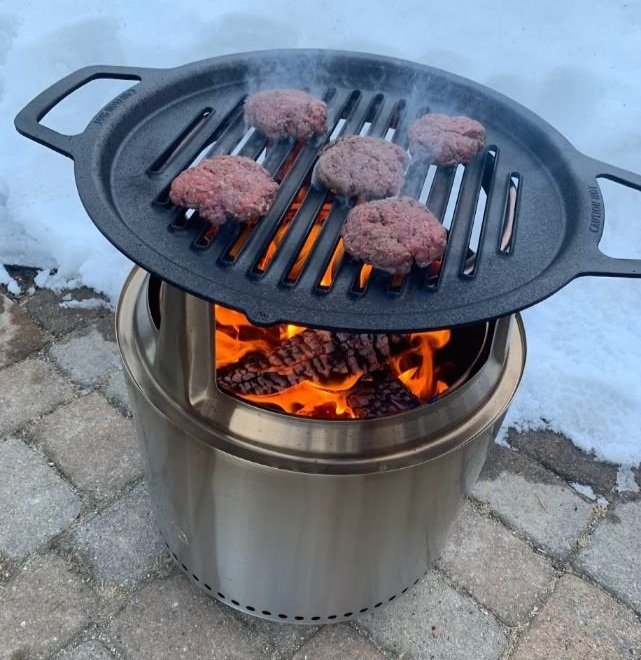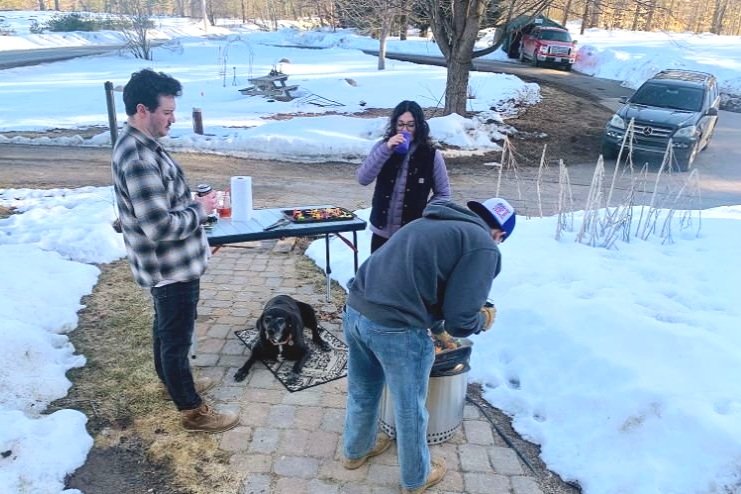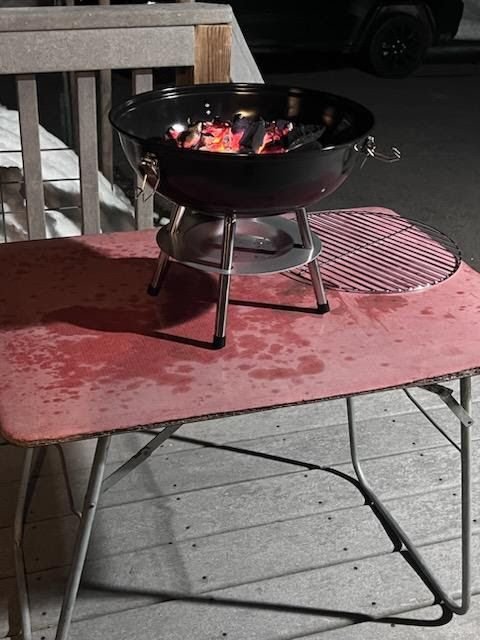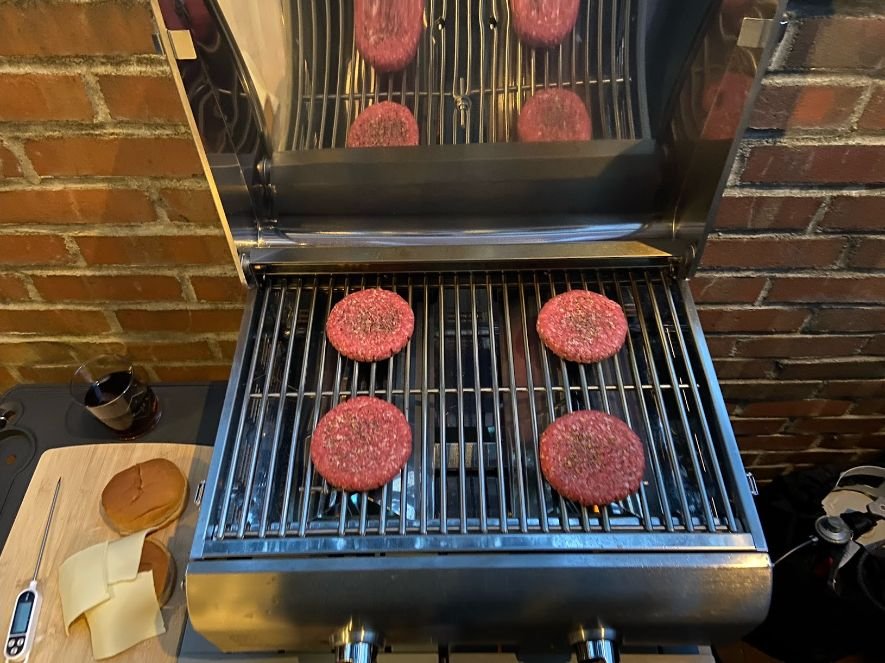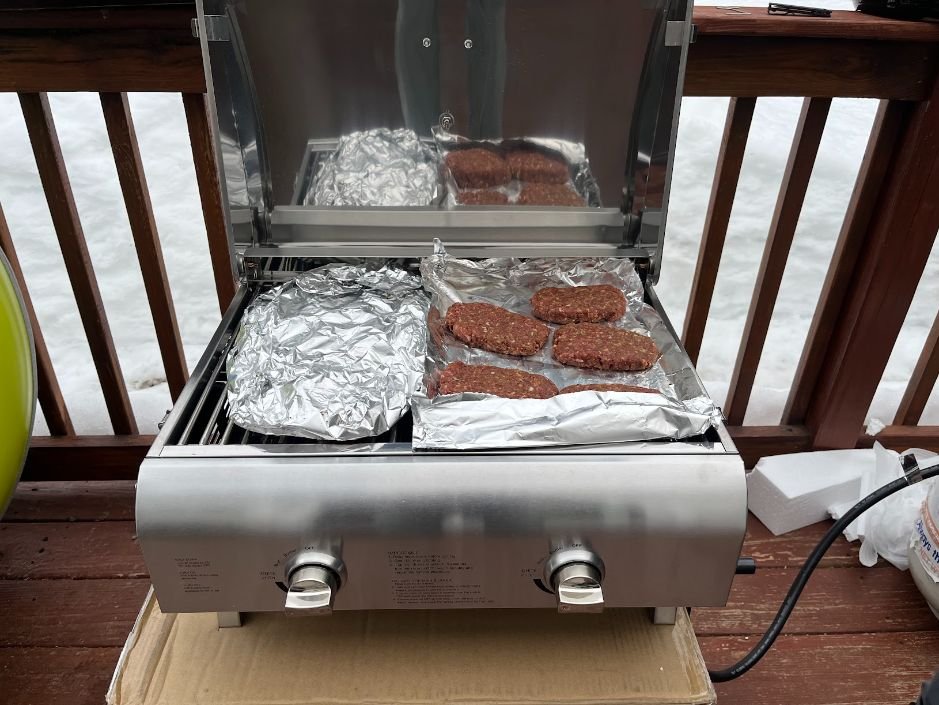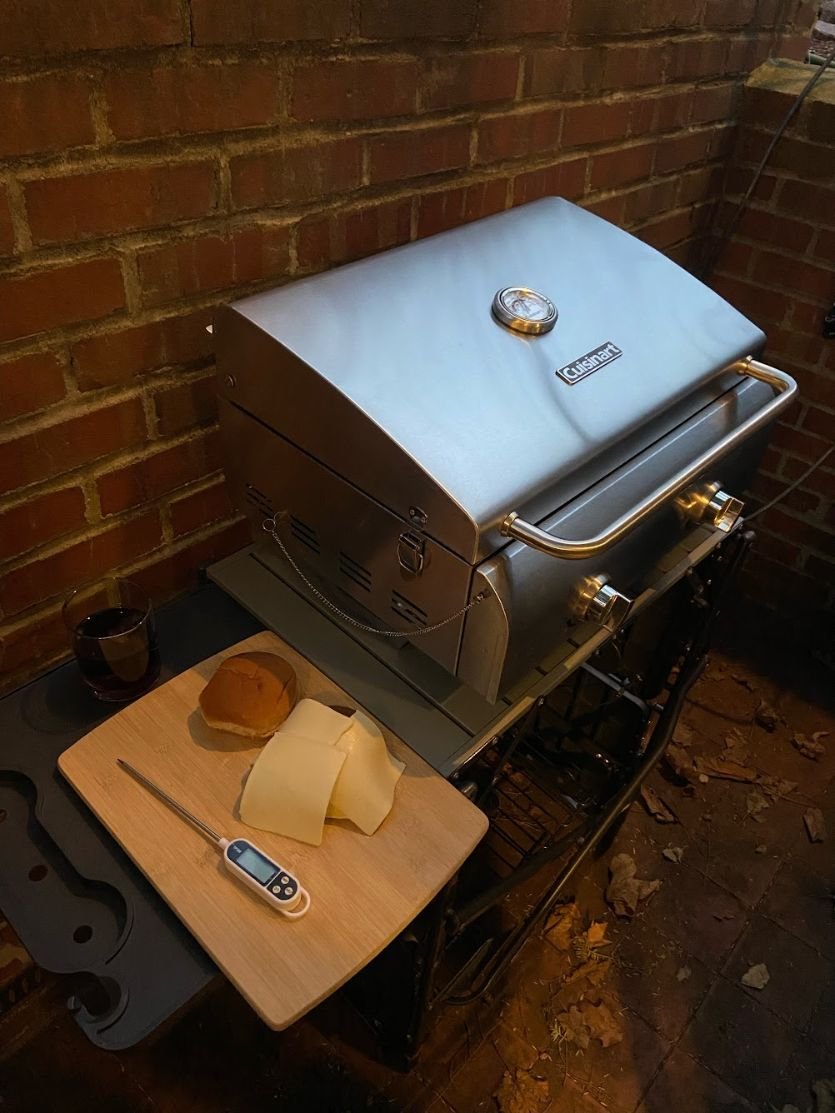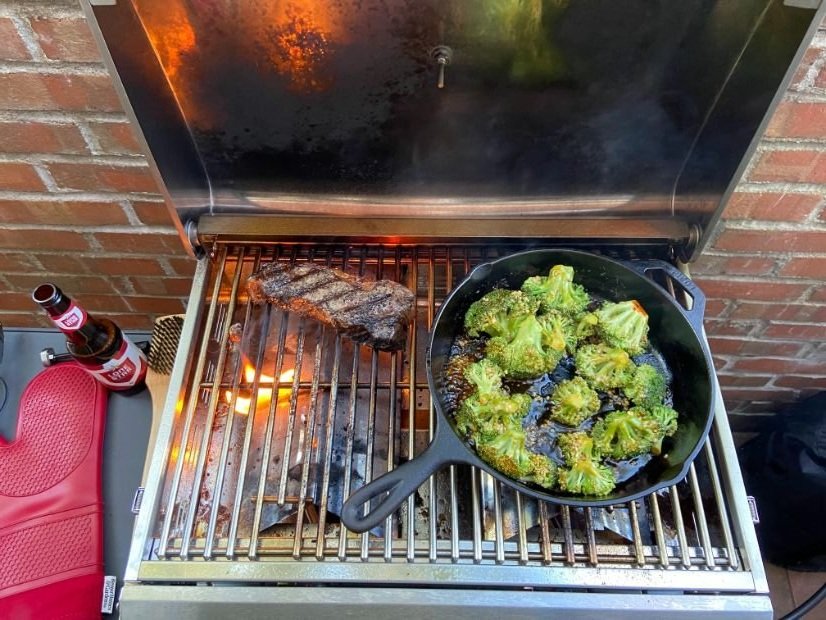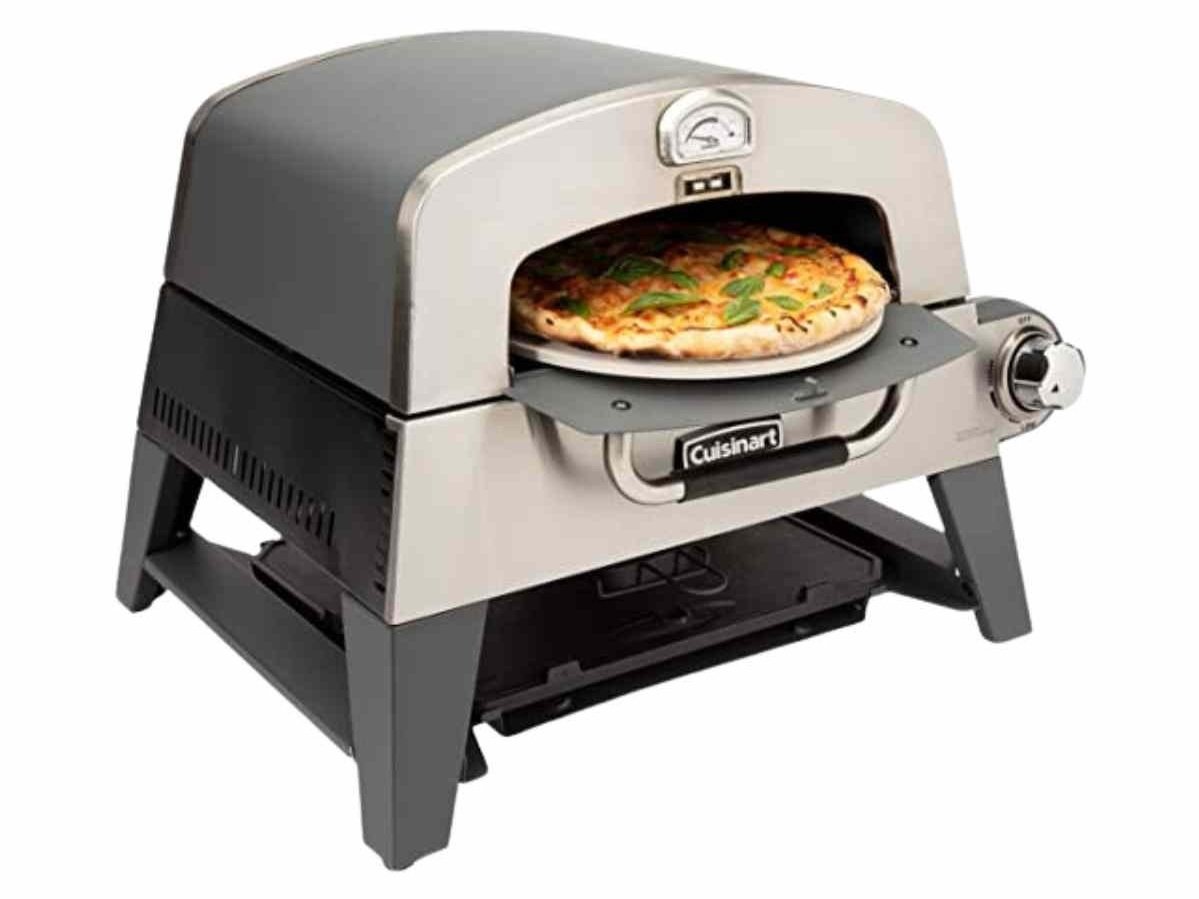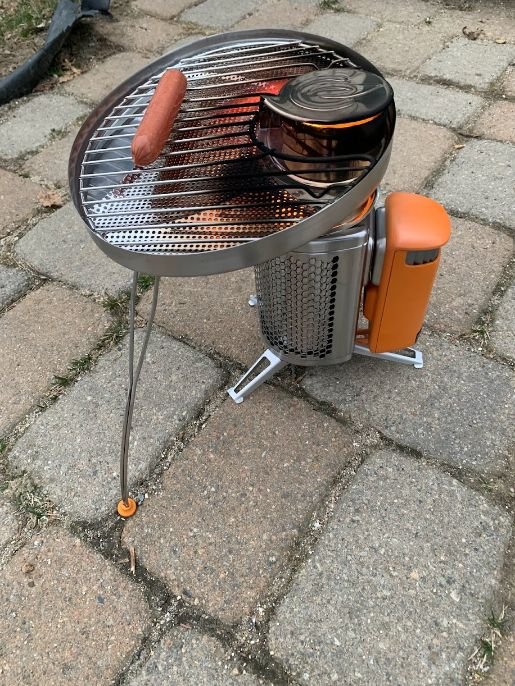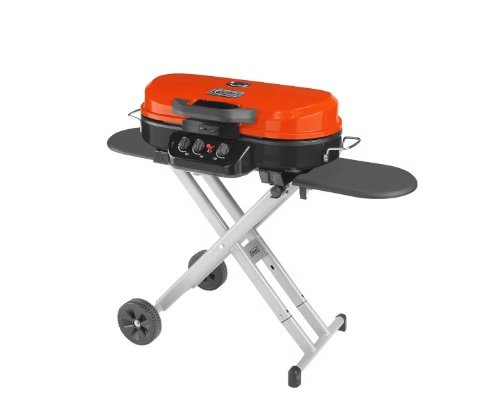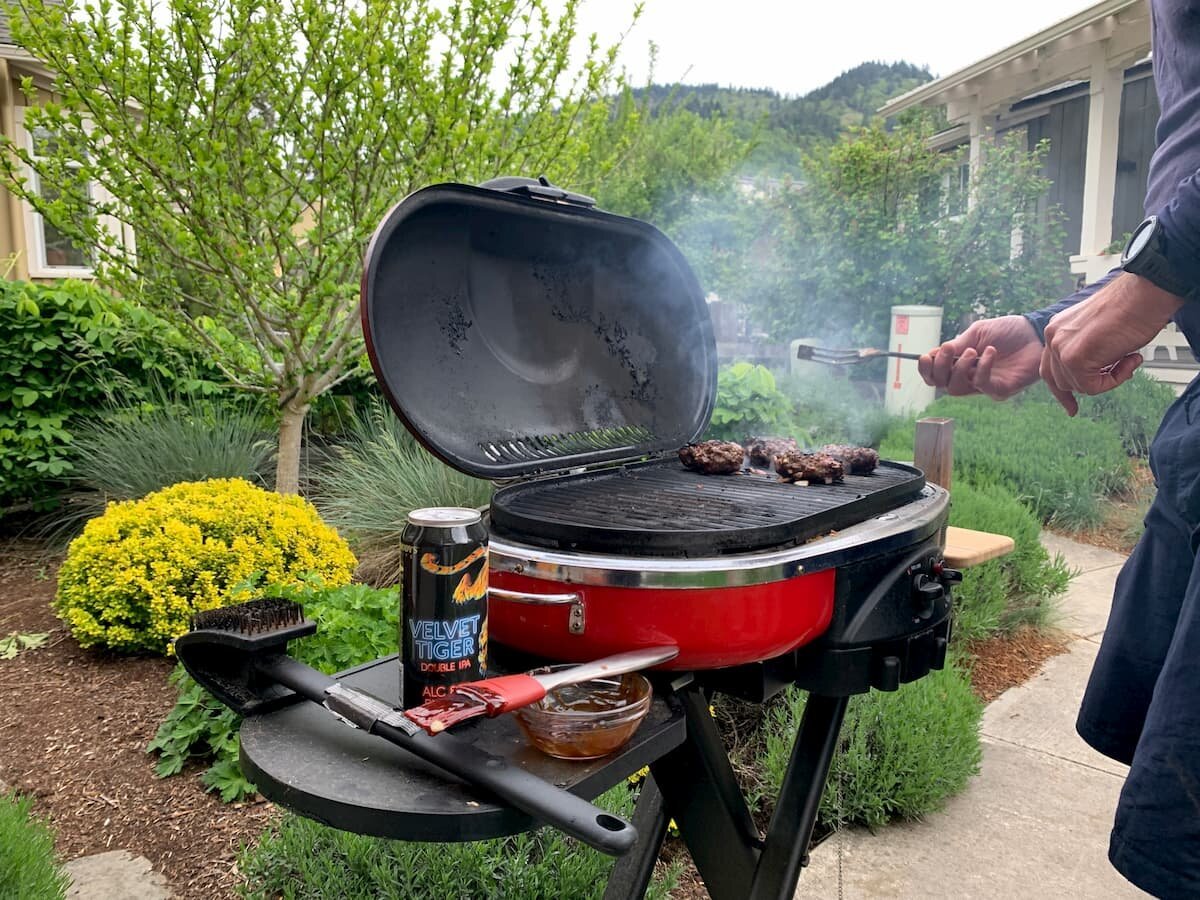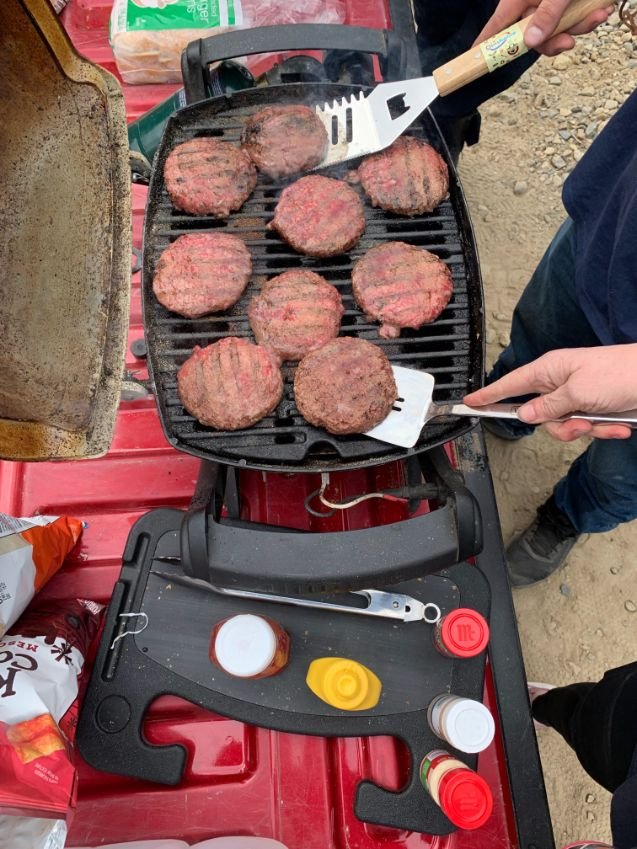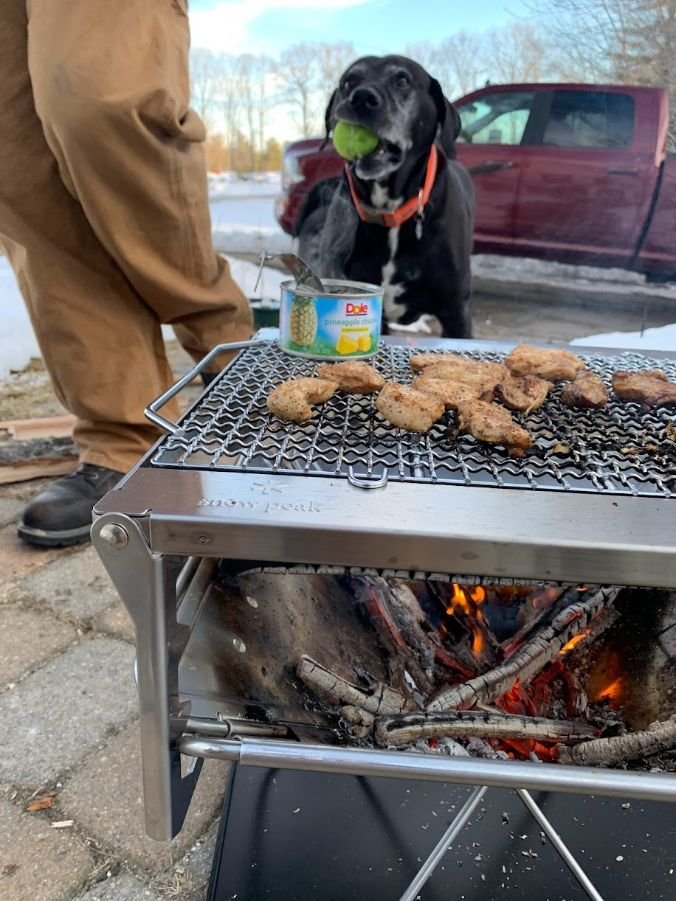Best Portable Grills For Camping of 2024
The Best Camping Grill and Best Portable Grill for Outdoor Trips: Charcoal, Propane, Pellet, and portable fire pits
May 15th, 2024
Home > Gear Reviews > Camping
Take your culinary skills to the next level on the trail, at the campsite, or on your next weekend BBQ with a portable grill.
We tested and reviewed camping grills to bring wherever you go, giving you access to flavor-filled, seared, and BBQ’d food to keep you out in the wild longer. If you’re the type of friend who brings gourmet dinners instead of freeze-dried packets, this article is dedicated to you—and the many hungry friends who will toast your chef’s choice over these easily-transportable grills.
To find the best portable grills for camping, we grilled dozens of burgers, hot dogs, veggies, and chickens to judge the ease of use, speed of cooking, and heat levels of each grill.
I’ve been a backpacking, rock climbing, hiking, and rafting guide in Alaska and Colorado; packing and preparing food for multi-day trips is second nature. Grilling burgers and dogs for 30 Boy Scouts on a river trip in northern British Columbia is no joke. In addition to being an outdoor writer, I’m a foodie who worked as a recipe editor for a major meal delivery company. As a volunteer firefighter, I take fire safety seriously when it comes to camping grills. If you’re looking for a portable camping grill that cooks well and is safe, read on.
This story may contain affiliate links, which help fund our website. When you click on the links to purchase gear, we may get a commission. This allows us to create reader-supported, objective gear reviews, independently selected by our editors — without costing you an extra cent. Thank you for supporting our work and mission of outdoor coverage for every body! Learn more.
Portable grills comparison table
| PORTABLE CAMPING GRILL | TREELINE AWARD | MSRP* | # OF BURGERS | FUEL | WEIGHT (LB) | DIMENSIONS |
|---|---|---|---|---|---|---|
| Snow Peak Takibi Fire & Grill | Best overall Read why |
$320 | 4 | Wood | 23 lbs. 8 oz. | 22 x 25 x 6 " |
| Solo Stove Bonfire Grill Top and Hub | Best firepit Read why |
$560 | 8 | wood, charcoal, pellets | 44.6 | 17.5 x 18.75 x 24.75" |
| Cuisinart CCG190RB 14 Inch BBQ Portable Charcoal Grill | Best affordable Read why |
$40 | 4 | charcoal | 2 lbs | 14.6 x 14 x 15" |
| Cuisinart CGG-306 Chef's Style Portable Propane Tabletop | Best portable gas Read why |
$290 | 8 | propane | 22 lbs | 17 x 21.5 x 26" |
| Weber Go-Anywhere Charcoal Grill | Best portable charcoal grill Read why |
$78 | 6 | charcoal | 13.45 lbs | 14.5 x 21 x 12.2" |
*Prices reflect MSRP. We note any discounts we see on our Deals page, which is updated daily.
Interested in camping gear? See our Camping section for our most popular stories.
The Winners
Best Portable Camping Grill: Snow Peak Takibi Fire & Grill
Dimensions: 17.75 x 17.75 x 13 in.; collapses to 22 x 25 x 6 in.
Weight: 23 lbs. 8 oz.
Fuel Source: Wood
Cooking area: 315 square inches
# of Burgers Cookable on This Grill Simultaneously: 4
Ground or Tabletop Set-up: Ground
What we liked: Stores easily, great carrying case, folds relatively flat, multi-position to adjust heat for a perfect marshmallow or grill, great airflow, Leave No Trace compliant-ash catcher makes for convenient use in campsites without fire rings, easily removable grill top for cleaning, set up in seconds
What we didn't like: Heavy
The Snow Peak Takibi Grill was by far one of the easiest grills we tested to set up and use. The base plate serves as an ash catcher and a steadier for the grill itself, thanks to notches in the baseplate designed to hold the legs of the fire pit itself. The stainless steel fire pit unfolds in one easy motion to give you an inverted pyramid of a basin, which is punctuated near the lip of the fire pit with ventilation holes to aid in stoking the fire. The Snow Peak Takibi Grill is our best camping grill for its clever folding design, quality of heat distribution, and ease of use.
The first night I landed in Japan for the ski trip of my dreams, we dropped our bags at our Tokyo hotel and headed straight for dinner. We feasted on soft shell crabs cooked over tableside, interlaced grills, and ate like royalty. Back home in Maine, when we fired up the Snow Peak Takibi Fire & Grill, I felt like I was right back in Japan—minus the traffic noises of Tokyo, plus a few more pine trees. It’s a winner of the international Good Designs Award and is well-loved by campers around the world for its ease of use, compact packable design, and quality of food it makes.
COMPARE PRICES OF THE SNOW PEAK TAKIBI FIRE & GRILL
Grilling pineapple on the Snow Peak Takibi in Maine in the winter.
This portable grill rests on a platform held on by collapsible, notched legs called the Grill Bridge (arguably the most challenging piece to set up in this whole system) and is easily removable for cleaning after your cookout. (Take note — this grill is designed to be set up on the ground, not on a picnic table.) The whole fire pit and grill fold down to be stored in a diamond-shaped carrying case for easy transport.
The height of the Takibi grill is perfect for sitting around the fire in camping chairs. Here, we’re grilling sausages on sticks outside of Joshua Tree National Park in a dispersed camping area with no established fire pit. The base catches all ashes making this fire Leave No Trace.
What makes this grill so special? Besides the easy set-up, we think it’s the interlaced grill top. Compared to the traditional spaced-out slats of a grill, the basket-woven design of the Snow Peak Takibi Grill allows you to grill smaller pieces of meats and veggies (like the chicken and pineapple combo we tested) without fear of losing those pieces through the slats and into the flames.
Chopping wood to feed the Snow Peak Takibi fire pit.
As one super-tester praised, “The height between the grill and the coals is perfect for getting hot enough to roast the perfect marshmallow, but not too hot that you’ll burn those kebabs. The quality of the heat distributed across the grill impressed even my mom — born and raised in Japan with high Japanese-style grilling standards. That’s how good this grill is!”
The height is also ideal for using as a fire pit. The height is perfect for setting up a few camping chairs and roasting marshmallows.
The portability of this camping grill is crucial. It’s not a light set up at 32 lbs—so don’t plan to schlep this one in a few miles up the trail. However, it’s perfect for a basecamp setup, car camping, RV camping, BBQ by the lake, or right in your backyard.
The Snow Peak Takibi base height is ideal for getting indirect heat for the perfect toasted marshmallow. Roasting marshmallows is a true pleasure with this camp grill.
Our testers have taken this grill everywhere from the forests of Maine to the Anza Borrego and Mojave Deserts of California to the temperate rain forest of the Olympic Peninsula in Washington. We’ve taken it to BLM dispersed campsites across the continent (for an LNT-friendly experience without an established fire ring).
The stainless steel components mean this camping grill is in it for the long haul; it’s easy to clean, set up, pack up, and transport nearly anywhere. Testers loved the airflow that the fire pit design provided the grill, which made lighting up the fire a breeze. They also remarked on the clean design of the firepan baseplate and how a quick scrub got the grill top back to spotless shape.
We like the Snow Peak Takibi so much, it’s been in our Best Gifts for Campers guide ever since it became available in the US. This is truly a piece of gear that is as much a pleasure to use in the backyard as it is far away from town.
Best Portable Firepit: Solo Stove Bonfire 2.0 Iron Grill Cooking Bundle
Dimensions: 20.5"D x 20.5"W x 9.5"H
Weight: 44.6 lbs
Fuel Source: wood, charcoal, or pellet
Cooking area: 17-inch cooking diameter
# of Burgers Cookable on This Grill Simultaneously: 8
Ground or Table Set-up: Ground
What we liked: Versatile, easy to clean, great airflow design, dual-purpose design with grill and firepit, can take 3 types of fuel (with accessories), portable grill top, gets very hot
What we didn't like: Doesn't have wheels, doesn’t pack down small, expensive, goes through a lot of wood quickly
This grill is the holy grail of versatile camping firepits-turned-grills. Solo Stove’s portable Bonfire fire pit design boasts rave reviews about its lightweight, dynamic airflow design that keeps your fire burning in an easily-contained and maintained fashion. The Solo Stove Bonfire Cast Iron Grill takes this design and adds a classic cast iron grill reminiscent of cowboying out West. The modification of the grill hub adds enough height to keep your food from burning in the intense heat of the fire pit (as our testers found out very quickly, don’t forget that hub!).
COMPARE PRICES OF THE SOLO STOVE’S PORTABLE BONFIRE FIRE PIT
The Solo Stove Portable Bonfire pit and grill gets a nice sear on burgers and generates a lot of heat for hanging around even in sub-freezing temperatures.
The camping grill top sports two handles to move to and from the flames. (Caution: use heat protection, the castiron gets just as hot on the handles as it does under the food.) The Solo Stove Bonfire Grill Top package was an instant favorite, with our testers raving about it. You still have a great fire pit to use after grilling, and the grill marks were second to none when it came to dinner — our kebabs and brats were artfully seared, and the marshmallows after were browned to perfection.
The pellet stove adapter on the Solo Stove Bonfire Pit allows you to use logs, charcoals, or pellets to get a great searing temperature.
If you already own the Solo Stove Bonfire (and REI sells that as a standalone), you can add on the grill top and hub separately, too.
But if you’re ready for the bundle, you’ll receive the following: a bonfire smokeless fire pit, a removable base plate/ash pan, a stand, a cast iron grill top, an elevated hub to hold the grill, and a carrying case for easier transport.
The grill on the Solo Stove Bonfire has two handles for easy transport and is perfectly distanced for heat.
Be warned—this combination is not light with the cast iron topper, which alone weighs about 20 pounds. Thanks to the brand-new pellet adapter, you can use logs, charcoal, or pellets. Although they can be harder to ignite, the pellet adapter worked smoothly and evenly for a great searing temperature.
The Solo Stove provides enough warmth for hanging around when it’s cold outside. Here, our testers are grilling up kebabs.
Our testers and everyday users were big fans for several reasons: it’s easy to use around dogs with contained flames, grills evenly, and is easy to clean (check out this guide to cleaning cast iron).
Using the Solo Stove Bonfire at home for a winter cookout.
Regardless, be cautious with kiddos, especially as the cast iron heats up. The only downsides mentioned were the time it takes to cool down the cast iron top (which is to be expected), and the price. It’s quite an investment, but it's totally worth it if you can catch it on sale.
Best Affordable Portable Grill: Cuisinart CCG190RB 14-Inch BBQ Portable Charcoal Grill
Dimensions: 14.6 x 14 x 15 inches
Weight: 2 lbs
Fuel Source: Charcoal
Cooking area: 150 square inches
# of Burgers Cookable on This Grill Simultaneously: 4
Ground or Table Set-up: Ground or Metal table
What we liked: Light, affordable, dual vents, lid locks, nonstick chrome-plated grill plate
What we didn't like: Not compact, short stand legs
We take back our “stereotypical” comment from before and, instead, introduce a classic portable camping grill that also captured the attention of our tight budgets. The Cuisinart 14-Inch BBQ Portable Charcoal Grill hits our basic desires—it’s portable, durable, and, most importantly, affordable.
At a whopping $40 retail (but often on sale for half that price), the Cuisinart allows you to bring a grill to the campsite, picnic, tailgate, or apres picnic for a great price—without breaking down on you during the second course. It's Amazon's Bestselling grill and even got a shout-out from Food and Wine magazine for the quality of food.
COMPARE PRICES OF THE CUISINART 14-INCH BBQ PORTABLE CHARCOAL GRILL
The Cuisinart 14 inch portable charcoal grill is small and portable but fits a surprising amount of food inside.
Take a chrome-plated cooking grate (read: nonstick and easy to clean), an enamel-covered “firebox” shell, four sturdy steel legs, and three locks surrounding the lid, and you not only have a user-friendly portable grill, but a pretty durable one for its price point. One hundred fifty square inches of cooking grate space allows ample room for up to 10 burger patties (although the author likes to pack on extra meat to hers, so more like 8 patties) with space allowed for heat to surround what you’re cooking. What we also love is how light this camping grill is. Barring the charcoal you’ll inevitably add, the grill itself weighs a mere 2 pounds.
The small but mighty Cuisinart grill doesn’t take up a lot trunk room when you pack it for trips on the go, but gives you a similar grill to what you’d expect of a bigger backyard grill.
Admittedly, this isn’t the easiest camping grill to hike a few miles down the trail to your campsite simply because of its rotund design — or to fit in a compact car. (According to our testers, it’s also not the easiest to set up at first—but worth it in the end.) However, this is the kind of grill that you can toss into your trunk to boost your car camping cuisine, strap to your sled en route to your winter camping trip, or even tuck into a raft or canoe corner. And at only $40, you won’t feel guilty if it gets a little dented by enthusiastic grillers in the process. Overall, the bang for your buck can’t be overstated with this tiny powerhouse of a grill.
Best Portable Gas Grill: Cuisinart CG-306 Chef’s Style Portable Propane Tabletop
Dimensions: 17 x 21.5 x 26 inches
Weight: 24 lbs
Cooking area: 275 Square Inch Cooking Surface
# of Burgers Cookable on This Grill Simultaneously: 8
Ground or Table Set-up: Tabletop grill
What we liked: Heats up quickly, easy to clean, sleek and durable stainless steel, packs up nicely, cooks evenly, propane
What we didn't like: Can burn a little too hot if you’re not watching
Two testers agreed the Cuisinart CGG-306 Chef Style Portable Propane Tabletop was the best portable gas grill they had ever cooked on. One was glad for its compactness while living in a garden-level apartment outside of Boston; the other was grateful for its portability between home and snowmobiling trips in New Hampshire’s White Mountains.
COMPARE PRICES OF THE CUISINART CGG-306 CHEF'S STYLE PORTABLE PROPANE TABLETOP
The Cuisinart Chef Style Propane grill adds a touch of elegance you’d expect to find from bulkier (and more expensive) grills.
“Hook up the propane, fire it up, and within minutes you’re grilling,” one tester said approvingly, “It’s the fastest-heating grill I’ve used.” (Careful—it heats up so quickly that you should check the integrated thermometer before throwing on your veggies, or they could cook too quickly.)
The Cuisinart Chef style grill has two burners that can adjust to two temperatures. On the left, we have vegetables that need to grill at a different temperature than the burgers on the right.
Thanks to two 10,000 BTU burners, you can grill up to eight ¼ pound burger patties simultaneously in under 6 minutes. However, if you want to cook two separate items (say, a vegetable alongside your steak), then two independently controlled burners allow you to set different temperatures. The twist-start ignition makes start-up even easier, so put away the matches. Like the removable grill top, the removable drip tray makes for easy cleanup.
Here, the Cuisinart Chef Style Propane set up on a camp table but resembles a more permanent backyard grill. This makes it ideal for campers who want one grill versatile enough to use at home and while in the woods.
When you’re ready to pack the grill, you can store your tools and propane hose under the grill's lid and lock it all up with the latches on the side. Use the lengthwise handle to carry the portable grill wherever you need to store it. This gives it a leg up over other portable gas grills, that are often heavy and bulky.
This portable grill has the elegance of a more permanent grill, so it’s ideal if you want one grill to use at home and while camping. We set it up on a portable camping table on the porch at a garden level apartment in Boston, and it was almost indistinguishable from a permanent grill.
The Cuisinart Chef has two burners that can heat at different temperatures, allowing you to cook steak and vegetables at the same time.
Our tester with limited city storage space was thrilled at the ability to store all the tools and tuck this camping grill into a corner or a closet when not in use; they were also glad that it was sturdy enough to handle being out in the spring weather on the terrace.
best Portable Charcoal Grill: Weber Go-Anywhere Charcoal Grill
Dimensions: H 14.5 in, W 21 in, D 12.2 in
Weight: 22 lbs
Cooking area: 277 square inches cooking surface
Ground or Table Set-up: Table or ground
# of Burgers Cookable on This Grill Simultaneously: 6
What we liked: Easy to clean, locking lid, ample grilling space, two separate burners, folding legs, easy carrying handles, built-in thermometer, integrated ignition, attached hose to connect to 20lb propane tank, ready to go right out of the box
What we didn't like: Bulky
This charcoal grill has a handle on the competition. (Pun intended—have you seen that handle?) We didn’t choose the Weber Go-Anywhere Charcoal Grill based on handles alone, but what stands out on this camping grill fits so well with its chosen title. Portability (and room for multiple patties) reign supreme with this camping grill. The cover locks in place with moveable, steel-plated legs that tuck up and around, making the top handle as good as a suitcase handle. However, if that doesn’t suffice, two other handles on the long ends will do the job, especially if you’re moving this portable grill with warm charcoal inside.
COMPARE PRICES OF THE WEBER GO-ANYWHERE CHARCOAL GRILL
The author having a tailgate party with the local volunteer fire department she serves on. They’re using the Weber Q1200 portable gas grill, which can fit a lot of burgers.
The rectangular dimensions of this grill add to its portability—at under two feet long, just over a foot high, and a foot across, this is one of the most easily packable grills for car camping and barbecues. It easily sets up on a tailgate, picnic table, or portable camping table so you can cook standing up, but is also safe to use on the ground.
However, this isn’t to say that this is too small of a grill, considering how it can hold six burger patties. But when you’re ready to pack up at the end of the meal (or the mid-summer camping trip), just fold up the steel-plated legs, slide the camping grill into the trunk of your car, and head back to town. The rectangular shape had no adverse effect on cook time, heat dispersion, or quality of sear, either, when compared to circular models.
A porcelain-enameled lid and base help you retain heat, while the double vents allow you to control the airflow for the best grilling results. The plated steel grate is easy to remove, clean, and heats up evenly, too. The one downside to this camping grill (if you can call it such) is the ~10 minutes of assembly required right out of the box. However, the value of such an easily carried, easily portable grill can’t be beaten, even with a few minutes of work at the top.
Best Portable Electric Grill: Hamilton Beach Electric Indoor Searing Grill
Dimensions: 12.4 x 16.73 x 6.81 inches
Weight: 8.14 lbs
Cooking area: 118 square inches
# of Burgers Cookable on This Grill Simultaneously: 6
Ground or Table Set-up: Table
What we liked: Dishwasher-safe ceramic grate, drip plate, removable lid with viewing window, adjustable temperature control, and power and preheat lights
What we didn't like: Requires an electrical outlet
Looking for a camping grill that can be used inside on a chilly day, out in your camper, or at the next work function? We think an electric grill is the way to go for versatility and the Hamilton Beach Electric Searing Grill is our winner for best electric grill.
COMPARE PRICES OF THE HAMILTON BEACH ELECTRIC INDOOR SEARING GRILL
The Hamilton Beach electric grill works indoors and outdoors (at campsites with hook-ups or for RV camping) making it ideal for people who live in small apartments.
Our testers were thrilled throughout the winner with the sear on their kebabs and patties and even more impressed at how fast this indoor grill heated up. “It was like grilling on the deck, but we enjoyed staying snug indoors while it snowed outside on a New England spring night. Our steak kebabs tasted just as good as they would have if cooked outdoors.”
We can’t recommend this for your off-grid camping (unless you have a heckuva solar setup) due to its need for an electrical outlet; however, there are a couple of great ways to work around it and enjoy the incredible grill marks and precise cooking of the Hamilton Beach Electric Searing Grill.
This portable electric grill is lauded as an indoor wonder, with everyday reviews praising its easy cleaning, removable grease tray, and quick-heating capabilities. There were some grumblings about a short cord not helping with countertop or camping table placement, the plastic grease trap not being dishwasher safe, and “no authentic BBQ flavor” added, but for our testers, we kept these expectations in check, and they were thrilled.
“I’m excited to take this RV camping and up to our camp in Maine,” said one tester. The ability to grill outside with an electric hookup appealed to them. It allowed them to take the grill inside in inclement weather but still grill outside with an extension cord out of their RV or electric hookup post in a campground.
If you’re looking for a mostly smokeless, apartment/condo-friendly porta indoor grill option that you can take car camping or use a a portable RV grill, this is a great one. Our testers loved the dishwasher-safe grill plate, the easy storage, and the flexibility of an indoor grill.
Best for Backpacking: Vargo Titanium Fire Box Grill 2.0
Dimensions: Grate size - 7.5” by 8”, Folded size in case - 6” by 8.5”, Open Height - 4.35”
Weight: 7.5 oz
Fuel Source: Wood/charcoal/pellets
Cooking area: 60 square inches
Ground or Table Set-up: Ground
# of Burgers Cookable on This Grill Simultaneously: 4
What we liked: 10-second set up, incredibly lightweight, compact, easy to transport, and could fit in the brain of a backpack
What we didn't like: No top for wind control/heat preservation, no ash pan or blanket included
The Vargo Titanium Fire Box Grill 2.0 is the most compact (read: small enough to fit in your pack's side pocket), the lightest (thanks to its small size and strong-yet-feather-light materials), and one of the easiest to set up out of any portable grill we tested. That’s why it wins our award for the best for backpacking, especially if you’re looking for a solo grill for your trail travels
COMPARE PRICES OF THE VARGO TITANIUM FIRE BOX GRILL 2.0
The Vargo Fire Pit is a small, portable grill and campfire for folks in the backcountry.
The only downside? It only sports enough room for about four small burgers, so isn’t the grill to bring for a huge party (unless your group has some patience).
The Vargo Fire Box uses a clever folding design to form a campfire pit.
The Vargo Fire box folds down flat for easy packing and portability.
As expected for something this light, t’s more challenging than other campfire-designed grills we tested to get the heat to the outer edges of the grill. However, if you know you have natural fuel readily available on the trail (or you’re willing to carry some pellets and fire starter along in place of liquid fuel), this grill will be your lightweight, fast-packing friend.
Cuisinart 3-in-1 Pizza Oven
Dimensions: 25 x 20 x 17.5 inches
Weight: 45 lbs
Fuel Source: propane
Cooking area: GRIDDLE: Cast iron griddle plate offers 233 square inches of cooking space. GRILL: Cast iron grill grate offers 260 square inches of cooking space. PIZZA STONE: 13” diameter.
Ground or Table Set-up: Table
# of Burgers Cookable on This Grill Simultaneously: 6
What we liked: Multi-functional, grill grate flips over to hold pizza stone, flattop griddle included, easy-to-use-and-read temperature gauge
What we didn't like: On the heavy side
Talk about versatility — this grill gives you a traditional propane grill grate, a cast iron flat top griddle, and a pizza oven wrapped into one. Our tester loved how easy it was to switch between the pizza oven feature and the cast iron grill with one flip of the grate, and appreciated its self-storage rack (for the grill top not in use) even moreso. You can open the pizza oven door to slide in your pie, or use the handle to lift the entire lid like a traditional grill.
COMPARE PRICES OF THE CUISINART 3-IN-1 PIZZA OVEN PLUS
Feed pellets or twigs into the top of the stove (the metal lid with the upside down Biolite logo opens up). A fan in the area below the orange area keeps the fire going. A thermometer reports the temperature.
The temperature is easily controlled with the knob, which makes for more even cooking, and fewer headaches (and burned pizzas). Overall, we loved how easy this grill was to set up, cook with, and clean up afterwards. It’s only downfall? It’s a whopping 45 pounds with all items included. This may not be the grill you hit the trails with, but it might be the grill you bring to the next car camping trip.
Contenders
UCO Flatpack Portable Stainless Steel Grill and Fire Pit (medium)
Dimensions: Dimensions-packed: 13.5" long x 10" wide x 1.1" thick; Dimensions-opened: 13.5" long x 10" wide x 11" tall Grilling Area: 13"(33 cm) x 10" (25.4 cm)
Weight: 3.3 lbs
Fuel Source: Wood/charcoal
Cooking area: 130 square inches
# of Burgers Cookable on This Grill Simultaneously: 6
Ground or Table Set-up: Ground
What we liked: Super portable, slim, fits in a backpack (comparable to a laptop), sides serve as a windbreak, 30-second set up
What we didn't like: No top for wind control/heat preservation
The UCO Flatpack Stainless Steel Grill may not fit the stereotype of your tried-and-true charcoal grill. (Although hats off to our best affordable pick, which fits that stereotype well.) But stereotypes are meant to be challenged, and this ultra-packable, ultra-portable grill does just that. For the camping, hiking, backpacking, or watersport-minded folks, this camping grill packs away just as easily as a Crazy Creek chair and serves the triple purpose of food prep, warmth, and ambiance under the stars.
VIEW THE UCO FLATPACK STAINLESS STEEL GRILL
The UCO Flatpack presents a simplistic set-up that most say should take 30 seconds, and we believe it could take you 10 with a few uses. Unfold the base, which consists of two hinged sides and two sturdy legs, and place the grate over the top.
When not used, the camping grill slides into a canvas bag for easy toting and less mess in your pack. (No one wants charcoal smudges all over their supplies.) Since it’s made from rust-resistant and corrosion-resistant stainless steel, the UCO Flatpack is easy to wash and wipe off, so packing doesn’t have to be messy.
The UCO Flatpack won us over for its price ($50 compared to the $100-$400 range of other camping grills we reviewed). We’re fans of its low weight (3.3 lbs), its spaciousness relative to its size (you could fit 6 burgers easily!), and its ease of packability (down to 1.5 inches thick). We also love that it works well in various circumstances, terrains, and grill-skill levels. However, with the killer reviews and outstanding tester notes for the Snowpeak Takibi Grill, we couldn’t quite give it the top winning spot.
Camping in the Mojave desert with the Biolite Campstove 2.
BioLite CampStove 2+ Complete Kit
Dimensions: CampStove - Height 8.25 inches (209.6 mm), Width 5 inches (127 mm)| Grill 9.5 x 12 x 3.5 in (24.13 x 30.48 x 26.67 cm)
Weight: Grill - 30 oz (850 g) | CampStove - 33 oz (935 g)
Fuel Source: Wood/twigs/pellets
Cooking area: 114 square inches (ovular)
# of Burgers Cookable on This Grill Simultaneously: 3
Ground or Table Set-up: Ground or metal table
What we liked: Temp-controlling fan, heat recharges battery, USB plug, and included USB-light, can burn any biomass fuel
What we didn't like: Hard to use on uneven terrain, a lot of parts
This multi-functional portable pellet grill keeps you fueled rain or shine with a battery-enabled fan that helps you control the heat levels and recharges with the heat produced by your fuel burning. While we loved that you can use any biomass fuel like twigs, pinecones, or pellets to keep your stove going, we appreciated the ability to use one heat source/base for both a stove pot and grill top.
COMPARE PRICES OF THE BIOLITE CAMPSTOVE 2+ COMPLETE KIT
We admit the grill setup is a little funky; the grill plate balances on two legs after connecting with the stove base, which itself rests on a three-point stand. This feature makes the entire setup tricky to balance on uneven terrain.
The Biolite Campstove 2 comes with a light that runs off the pellet stove (no electricity or batteries needed).
Feed pellets or twigs into the top of the stove (the metal lid with the upside down Biolite logo opens up). A fan in the area below the orange area keeps the fire going. A thermometer reports the temperature.
But, the ability to control heat, power a lamp, and switch to a pot within the same system made this a valuable “grill of all trades.” Take note, though, we would not recommend setting this grill or stove up on a wooden picnic table; a metal table, a flat rock, or the ground would be the best option for set up.
Green Mountain Trek Prime Wi-Fi Controlled Portable Wood Pellet Tailgaiting Grill (Formerly Davy Crockett)
Dimensions: 16 x 32 x 24 inches
Weight: 65 lbs
Fuel Source: pellets, 12V or 120AC
Cooking area: 219 sq. in
Ground or Table Set-up: Ground
# of Burgers Cookable on This Grill Simultaneously: 12
What we liked: Digital WiFi controller (control and monitor through mobile app), meat probe, peaked lid for rib racks, convenience tray with utensil hooks, and thermal sensor which constantly monitors grill temperature
What we didn't like: Depends on WiFi and power, bulky
The Green Mountain Trek Prime pellet grill is the new branding of a very popular grill, the Davy Crockett. Grillers loved the smoker-turned-grill that feeds hardwood pellet smoke into their steaks, burgers, and chicken thighs, and the ease of using the grill — in an area where they could easily access power and WiFi, however.
COMPARE PRICES OF THE GREEN MOUNTAIN TREK PRIME PELLET GRILL
In the end, this grill is a great option for those who want a smaller version of a pellet smoker or grill to transport more easily — but we don't think will be useful/effective in most camping situations without good service or Wifi. It's also large and bulky (24 in. Height x 32 in. Width x 16in. Depth), even more so than the Solostove Bonfire, which would be the next biggest in size. With the pellet adapter option on the Solo Stove, we felt more confident in its versatility as a portable pellet grill option than we did the Green Mountain Trek Prime. The Green Mountain was also expensive—with the price jumping up more than $100 in the last year.
Coleman RoadTrip 285 Standup Grill
Dimensions: 28.78 x 18.31 x 14.17 inches
Weight: 47 lbs
Fuel Source: propane
Cooking area: 285 sq. in
Ground or Table Set-up: Ground
# of Burgers Cookable on This Grill Simultaneously: 8
What we liked: versatility, can be used at home and for camping
What we didn’t like: price
If there’s one thing we like at Treeline, it’s gear that can be used for more than one purpose, which is why we like the Coleman RoadTrip 285 Portable Stand-Up Propane Grill. It’s portable, with quick-fold legs and two wheels for easy transportation.
Why have one grill for home use and another grill for camping and tailgating, when one grill can do both? It’s small enough to fit in the trunk of a car, and the optional carrying case keeps grime from getting all over the interior of your car.
COMPARE PRICES OF THE Coleman RoadTrip 285 Standup Grill
Grilling mango burgers from the patio. The Coleman Roadtrip is fancy and sturdy enough to use at home as it is on a camping trip. It’s a good option if you want a grill to mostly use at home that can occasionally be used at the campsite. Photo by Naomi Hudetz.
It’s powerful, with cooking power up to 20,000 BTUs. We’re impressed with the power - we’ve always gotten the perfect char on burgers, steaks, and veggies. It also has three temperature-adjustable burners, so your vegetables don’t get overdone.
If you regularly cook for large groups, it may not work for you. And while the price is reasonable for most backyard set-ups, it’s on the pricier end for portable camping grills we tested.
Buying Advice
Type of fuel: Charcoal vs. Gas vs. Wood vs. Electric
How do you fuel your fire? There are pros and cons to all modern options for today’s portable camping grills, and while we could write a thesis about each, we’ll stick to the basics in this section.
CHARCOAL:
This residue from super-heated, oxygen-deprived wood burns incredibly well and gives your food a smoky, rich flavor. Because it has a higher carbon content, it has more potential energy (read: it will burn hotter, steadier, and cleaner than wood) and makes for a more even cooking temperature than just wood. Charcoal grills are popular for backyard camping grills for this reason and you'll see smaller but similar designs used in portable charcoal grills. The best charcoal grill we tested is the Weber.
However, starting a charcoal fire can be tricky. Most people will “cheat” and utilize lighter fluid, while others will build a mound of charcoal briquettes around newspaper, which ignites more easily. Here’s a good article from The BBQ Host on how to light your charcoal without lighter fluid.
WOOD:
It’s the most traditional fuel but not always the most predictable. Wet or green wood will keep you from a good ignition, but even dried wood can burn inconsistently. If you grill with wood, look for kiln-dried hardwood. (Or be prepared to feed that fire pretty often.)
Pellets: portable pellet grills run on pellets designed for cooking, smoking, and fueling grills. Examples include the Biolite pellet adapter, Vargo, and Green Mountain Trek.
GAS/PROPANE:
Propane gas is the gold standard of fuels. Propane grills are lightweight (although the containers add some weight), easy to transport, and (generally) easy to light. However, trouble with fuel lines can add a level of intricacy to cooking while camping, so be sure to read up on your owner's manual. Gas grills are easy to regulate and adjust for direct heat and indirect heat, so most folks prefer it for their cooking options.
ELECTRIC:
Electric grills aren't as popular as most camping options (as electricity isn’t usually prominent in campsites out in the woods), but it’s most certainly an option for car camping and RV camping. This kind of fuel heats the griddle evenly and accurately. It's also a good option for folks who live in small apartments who want a grill that can be used at home and also in a campsite.
Size
Size is a matter of your available space (storage and transport) and preference. If you’re crunched for space, look for camping grills with a small footprint or the ability to break down small (like the UCO Flatpack or Snow Peak Takibi). Be sure to measure your space before you purchase! If you have the room and desire a larger grill, choose what you’d like and enjoy.
The Weber portable grill can fit a lot of burgers on one surface, ideal for bigger groups.
Cooking Area
Our argument for cooking space goes hand in hand with our discussion of “how many people are you cooking for” below and the question of what size you’d like above. Most camping grills will give you space for at least 4 burger patties at a time, but our largest grill option (the Green Mountain Trek) gives you enough space for 12 patties. Look for a camping grill with the amount of space you want to cook on, whether for many people at once, or just one or two. Remember that a larger cooking space also (usually) correlates to a larger grill body to store when it’s not in use.
Portability
Welcome to the golden ticket to our story. Portability is crucial and foremost on our list of considerations since we want a grill we can easily take with us to our favorite adventure spots.
Portability comes down to 3 things: weight, ease of carrying (read: bulk and handles), and compactness. Some camping grills can be larger (like the Cuisinart Chef’s Style) but sport easy-to-use handles, locking lids, and collapsible legs. Other grills, like the Snow Peak Takibi or UCO Flatpack, are designed to collapse fully for the ultimate ease of transport. If you want to bring your grill further off the grid, one of these fully-collapsible options might be right up your alley. But if you’re just looking for something easy to carry from the car to the campsite, look for a grill that looks easy to move.
The Snow Peak Takibi has a deep pit that catches ash as well as a metal tray to prevent scarring the land, meaning it’s a good option for making your campfire Leave No Trace. It has a sturdy base that doesn’t wobble, contributing to campfire safety.
Safety
Speaking as a firefighter here, safety should be high on your list of considerations. Do you plan to use your grill on the ground, or on a table? Will you be in a wilderness area with LNT requirements, or based in your own backyard? Will you be using the grill near your house, or in an area full over overgrown brush, or on a sandy bank? Wherever you are, make sure you have fire-suppressing safety measures in place — whether that be extra water, a pailful of sand and a shovel, or a fire extinguisher.
Output Power
Output power will depend on what type of fuel you prefer. As we’ve discussed, wood is more unpredictable and harder to measure regarding output. Charcoal produces a steadier heat, but either of these options would require a thermometer to gauge. (Fortunately, a lot of camping grills include an integrated thermometer, so that's one less thing for you to remember to pack for your camping trip.)
Propane grills measure their output in BTUs (British Thermal Units). The Energy Information Administration defines BTUs as “the quantity of heat required to raise the temperature of one pound of liquid water by 1 degree Fahrenheit at the temperature that water has its greatest density (approximately 39 degrees Fahrenheit).” As propane is pre-packaged and measured, it’s easier to calculate its BTUs when it comes to grilling.
Wind Resistance
A good grill will consider wind without squelching the oxygen intake that fire needs to continue burning. If your grill doesn’t come with a lid, look at investing in a windscreen. If you can, set up your grill with some kind of protection from the wind. This protection can come from behind a vehicle, tent or shelter, or by blocking the grill from the wind with additional equipment.
The Cuisinart pizza oven gets up to 700 F degrees, ideal for pizzas (but not necessary for cooking other food items).
How to choose A PORTABLE GRILL
Do you want a grill with a stand and/or a case?
Here’s the question: do you want a grill that stands alone, stands on a tabletop, or sits flat on a cooking surface? Much of this boils down to where you’d like to use your grill most often. Camping grills like the Solo Stove are designed to stand alone on the ground, while grills like the Cuisinart Portable Charcoal Grill have legs but need to be set up on a tabletop. The Presto Electric Grill, though, requires a tabletop, regardless. When in doubt, the option of legs or no legs (like on the Cuisinart Chef’s Style Portable Propane Grill) is a great one to have.
A case, on the other hand, can come in even handier. A case protects your grill from grime and dust when it’s not in use, dirt and sand in between uses, and keeps it from rust, salt, and sun damage while camping — as well as your vehicle from grease and grime when transporting. Cases can be hardcover or softcover, give you extra handles for transport, and add cushion for bumps in the road (or at the camp kitchen). If your grill doesn’t come with a grill case, consider purchasing one (or a grill cover for in-between).
Do you want a griddle?
Griddles can change the game when it comes to your outdoor cooking game. Without worrying about food falling through the slats of a grill, your options open up; you can stirfry and hibachi in the woods or griddle up veggie burgers and fry up eggs in the morning. Is a griddle necessary? Not necessarily. If your desired grill doesn’t already come with a griddle option, you could opt for an additional griddle plate (like this option for round grills or this rectangular option). However, griddles aren’t always the best option for portability's sake.
Fuel connector for propane gas on the Cuisinart Pizza Oven.
What type of fuel do you prefer?
This factor is arguably the biggest when it comes to choosing your grill. Some folks can’t live without the added flavor of charcoal, while others prefer liquid propane's predictable and more easily controlled direct heat and indirect heat. We recommend propane for better portability, as it’s more compact and lighter. However, charcoal is available in smaller or larger bags, depending on your needs. Choose what works better for your taste buds and the space in your car.
How many people are you cooking for?
How many burger patties, hot dogs, or veggie burgers do you need to cycle through for that Apres ski barbecue or Sunday afternoon grill session by the river? There’s nothing wrong with a smaller grill if your main goal is compact portability, but if you plan to play the chuckwagon for your friend group’s adventures, a larger grill might be better in the long run.
How much space do you have?
Besides your fuel preference, this might be the second most important question to ask yourself. That might be the best option if you have the space (and desire) for a larger portable grill (like the Green Mountain Trek). However, if you’re crunched for space, look for either a small footprint or the ability to break down small (like the UCO Flatpack or Snow Peak Takibi). Plan out where you want to store your grill when it’s not in use, and how you plan to transport it to your outdoor adventures. Be sure to measure your space before you purchase!
How much do you want to spend?
Budgets are important to us at Treeline Review. Outdoor gear can be expensive, and we want to ensure affordable options are available to everyone. We found options under $30 but also have options with all the bells and whistles for a few hundred dollars. Spending more doesn’t always mean you’ll get better quality, so using the other factors we’ve talked about above, choose a grill that fits both your needs and your budget.
The Biolite Campstove after grilling up some hot dogs.
FAQ
How to clean a portable grill?
The BBQ Depot has an excellent guide to cleaning different grills and grill parts, as does Popular Mechanics. When in doubt? Grab some grease-cutting dish soap, warm water, and a grill brush, and start scrubbing. (Except with cast iron, keep soap away from cast iron at all costs. Here’s how to clean cast iron.) Check your manufacturer's recommendations for cleaning products and advice.
How to light a portable propane grill?
Most propane grills will have an ignition button installed for easy lighting. If, however, that is not included or that button fails, here’s how to light your propane grill by hand.
Make sure the lid is up or off. Turn the dials to ignite or on to high. If there’s a grate, lift it carefully to reach the burner. Hold the match or the lit end of a lighter to the burner where the propane comes out. Once the burner has ignited, replace the grate and adjust the burner as you need.
How to light A portable charcoal grill?
Some folks opt for the easy route and spray their charcoal in lighter fluid. While we understand the desire for an easy, fast burn, we just can’t get past the taste of lighter fluid on our food.
Check out this resource from the BBQ Host on how to light a charcoal grill without lighter fluid. If you treat your charcoal like a stacked-wood campfire, with kindling or newspaper or another form of firestarter, you should succeed at lighting your charcoal grill.
If you can’t, and you left your lighter fluid at home, gather dry pine needles, extra napkins from your center console, or even leftover dryer sheets to get your charcoal grill going.
Care and maintenance tips
Taking care of your portable grill before, during, and after your camping trips is essential to ensure its longevity and ability to make food for you when you need it.
Before firing up your grill, it's crucial to familiarize yourself with the grill's setup. Read those instructions.
This may seem obvious, but ensure it's placed on a stable, flat surface away from any flammable materials.
Check your fuel levels, if applicable. There's no bigger bummer than running out of fuel before you meal is done when you're miles from a store that sells fuel.
After each meal, take the time to thoroughly clean it. Allow it to cool completely before using a grill brush or scraper to remove any food residue and debris from the grates. Wipe down the exterior surfaces with a damp cloth or sponge, and don't forget to empty and clean out any ash or grease traps. This isn't only food for your grill but also minimizes the chances critters will be attracted to your camp.
Regular maintenance is key to keeping your grill in top shape. Inspect it for any signs of damage or wear, such as rust or loose parts, and address them promptly. Tighten any loose screws or bolts, and lubricate hinges and moving parts as recommended by the manufacturer.
Gas grill users should check the connections for leaks using a soapy water solution. The instructions should have details on how to do that for your specific model.
When the camping trip is over, store the grill in a dry, sheltered location to prevent rust and corrosion. Most of the grills we recommend are designed to handle some weather, but prolonged time outside can do a toll on any grill. Use a fitted cover to protect it from the elements. The same goes for your fuel. Store charcoal and wood in dry places to prevent it from getting damp.
When you're on the road with your grill, make sure it is secured in the back of your truck, van or adventuremobile to prevent it from moving around and getting damaged. If you've got a gas grill, make sure you turn off the gas valve and disconnect the fuel source before transporting it.
We recommend picking up basic grilling accessories. A grill brush, sponge, dish soap, and paper towels will come in handy for quick cleanups while camping. It may feel like you've already invested a lot of money in a grill, but the cleaning accessories really will help with longevity.
Lastly, when disposing of ashes from a charcoal grill, make sure they've cooled completely before disposing of them in a designated ash disposal area. If you aren't sure where that is, ask your campground host. Avoid dumping hot ashes near vegetation or other flammable materials.
The Solo Stove Bonfire can generate quite a flame when you light it, especially right after adding pellets.
Safety tips for camp grilling
When it comes down it to it, grilling is a form of controlling fire and fire can be dangerous. This is especially true when on camping trips, where you may be far from Urgent Care and near vegetation that can be flammable.
Start by carefully selecting the location and setting up your grill. Choose a well-ventilated area. Don't set up inside a tent. If there are tree branches above your grill, move away so there is clear sky above.
Set your grill up on a stable, flat surface to prevent any risk of tipping over during use.
When it comes to fire safety, it's essential to have appropriate measures in place. Keep a fire extinguisher, bucket of water, or sand nearby for emergencies. Never leave the grill unattended while it's in use, and avoid overloading it with too much fuel or food to prevent flare-ups.
If you're camping (not in your backyard) check that there isn't a fire ban or grill ban going on. If you're camping at an established campground, the campground host may be able to fill you in on current regulations.
For gas grill users, conducting a pre-use safety check is crucial. Before each use, inspect the gas connections for leaks using a soapy water solution. If you detect the smell of gas while cooking, immediately turn off the gas supply and move away from the grill. Remember always to open the lid of a gas grill before lighting it to prevent gas buildup.
Those using charcoal grills should use only charcoal starter fluid designed for grills, and never add starter fluid to hot coals, as this can cause dangerous flare-ups. Allow the charcoal to cool completely before disposing of ashes in a designated ash disposal area to prevent accidental fires.
When it comes to food safety, it's essential to practice proper hygiene and cooking techniques. Keep items in a well-insulated camping cooler with plenty of ice right until cooking. Use separate utensils and cutting boards for raw and cooked foods to avoid
A well-designed grill will be popular with everyone.
How we tested
We tested our camping grills in various environments—from snowy Maine winter afternoons to spring evenings—with different testers, including professional outdoor guides, everyday camping enthusiasts, and amateur chefs. Each tester put these grills through a series of criteria to determine their rating.
Key criteria included: ease of set up, ease of cleaning, quickness to heat up, ease of temperature control, and portability.
We grilled everything from veggie kebabs to bratwursts and deer steaks, and from dinners for one to almost a dozen hungry hikers.
Our camping grills were tested from the Mojave Desert to the pine forests of Maine, from warm summer nights to snowy winter evenings—during afternoon grills and by camping lantern at night.
The author, Josette Deschambeault, is an outdoor writer and river and backpacking guide.
About the author / Why you should trust us
My favorite aspect of guiding (whether on the Arkansas River, backpacking through Colorado’s Collegiate Peaks, rock climbing around Denver for a day, or just driving people into the Yukon) was the meals. I loved making scrumptious meals that paired with a great outdoor day. I even hail myself as the snack queen who plans her trips around great meals (and great brews afterward) and will never be caught without something extra to munch on.
Grilling comes second nature to me, especially as a river guide and firefighter; cooking over an open a campfire with a grate or pulling out a mini grill for a tailgate after a long day outdoors can’t be beaten. I’ve worked for Green Chef, a meal kit company that featured several grilled dishes (that I happily tested out). Cooking with wood, charcoal, and propane in the elements is my jam, and this story allowed me to reignite (if you will) my passion for grilling.
I’ve also been a backpacking, rock climbing, hiking, and rafting guide in Alaska and Colorado; packing and preparing food for multi-day trips is second nature. Grilling burgers and dogs for 30 Boy Scouts on a river trip in northern British Columbia is no joke.
My gear expertise stems from 6 years of gear reviews for Backpacker Magazine, 8 years of guiding, years of camping adventures, and a plethora of gear-head friends. I’m also a volunteer firefighter, which means fire safety is a big concern for me.
In addition, I’ve written outdoor lifestyle pieces for NRS’s Duct Tape Diaries, REI’s Uncommon Path Magazine, and Powder 7 Ski Shop’s Lift Line Blog. (For additional publications and upcoming articles, check out my website.)
Let it be known: no one in my family (including myself) is sponsored, an ambassador, or an employee of any company mentioned here. Our reviews are unbiased, and we do this to help you find the best product for the price. Treeline Review doesn’t accept sponsored content, native advertising, or paid reviews.
You can see all of Josette's articles on her author page.

